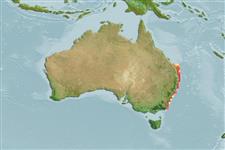>
Clupeiformes (Herrings) >
Dorosomatidae (Gizzard shads and sardinellas)
Etymology: Herklotsichthys: After Janus Adrian Herklots, Australian ichthyologist, 1820-1872.
Eponymy: Dr Geoffrey Alton Craig Herklots (1902–1986) was a British biologist, botanist and ornithologist at the University of Hong Kong (1928–1941). [...] Francis(co) Louis Nompar de Caumont, Comte de Laporte de Castelnau (1810–1880) was a career diplomat and naturalist who was born in London, studied natural science in Paris, and then led a French scientific expedition to study the lakes of Canada, [...] (Ref. 128868), visit book page.
More on author: Ogilby.
Environment: milieu / climate zone / depth range / distribution range
Ecología
marino; agua dulce; salobre; rango de profundidad 0 - 50 m (Ref. 188). Tropical; 24°S - 39°S, 149°W - 156°E (Ref. 188)
Southwest Pacific: eastern Australia (Queensland southward to New South Wales). Possibly merely an eastern subspecies, of which Herklotsichthys blackburni is the western counterpart; however, it seems equally close to Herklotsichthys Species C. Reported from lower Fly River, Papua New Guinea (Ref. 13533).
Tamaño / Peso / Age
Maturity: Lm ? range ? - ? cm
Max length : 20.0 cm SL macho / no sexado; (Ref. 33617); common length : 14.0 cm SL macho / no sexado; (Ref. 33617)
Espinas dorsales (total) : 0; Radios blandos dorsales (total) : 16 - 19; Espinas anales: 0; Radios blandos anales: 17 - 21; Vértebra: 41 - 42. Distinguished from most other Australian Herklotsichthys by lacking spots on the flank and lacking elongate wing-like scales underneath pre-dorsal scales. Most closely resembles H. blackburni but has more lower gill rakers. Separated from H. gotoi and Herklotsichthys species C by having 3 distinct dark lines upper flank. Upper caudal tip black; dorsal fin with distinct pale band.
Schooling species found in estuarine and coastal marine waters (Ref. 33617, 75154). Adults undergo spawning migration from coastal waters into upper reaches of estuaries during summer and autumn (Ref. 33617).
Life cycle and mating behavior
Madurez | Reproducción | Puesta | Huevos | Fecundidad | Larva
Whitehead, P.J.P., 1985. FAO Species Catalogue. Vol. 7. Clupeoid fishes of the world (suborder Clupeoidei). An annotated and illustrated catalogue of the herrings, sardines, pilchards, sprats, shads, anchovies and wolf-herrings. FAO Fish. Synop. 125(7/1):1-303. Rome: FAO. (Ref. 188)
IUCN Red List Status (Ref. 130435: Version 2024-2)
Threat to humans
Harmless
Human uses
Pesquerías: escaso valor comercial
Herramientas
Special reports
Download XML
Fuentes de Internet
Estimates based on models
Preferred temperature (Ref.
123201): 19.4 - 24.5, mean 22.5 °C (based on 24 cells).
Phylogenetic diversity index (Ref.
82804): PD
50 = 0.5002 [Uniqueness, from 0.5 = low to 2.0 = high].
Bayesian length-weight: a=0.00871 (0.00415 - 0.01826), b=3.06 (2.89 - 3.23), in cm total length, based on LWR estimates for this (Sub)family-body shape (Ref.
93245).
Nivel trófico (Ref.
69278): 3.1 ±0.3 se; based on size and trophs of closest relatives
Resiliencia (Ref.
120179): Alto, población duplicada en un tiempo mínimo inferior a 15 meses (Preliminary K or Fecundity.).
Fishing Vulnerability (Ref.
59153): Low vulnerability (14 of 100).
